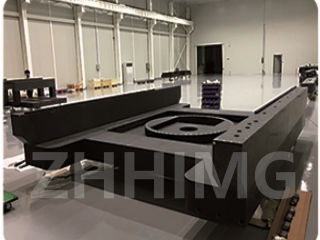Granite is a commonly used material in semiconductor equipment due to its excellent dimensional stability, stiffness, and vibration-dampening properties. Despite its durability, proper maintenance and upkeep are necessary to ensure optimal performance and extend the lifespan of granite components.
The following are some essential requirements for the maintenance and maintenance of granite components in semiconductor equipment:
1. Regular cleaning
Granite components must be regularly cleaned to prevent the build-up of contaminants that could compromise their quality and accuracy. This involves using non-abrasive cleaners and soft brushes to remove any debris or dirt that may have accumulated on the surface.
A regular cleaning schedule also helps to maintain the aesthetic appeal of the granite components and enhances the overall cleanliness of the semiconductor equipment.
2. Lubrication
The moving parts of granite components require proper lubrication to minimize friction and wear. However, it is critical to use lubricants that do not react with granite or the other materials used in the equipment.
Silicone-based lubricants are a popular choice for granite components as they are non-reactive and do not leave behind residue. However, it is essential to follow the manufacturer's instructions to avoid over-lubrication, which can result in contamination and other issues.
3. Calibration
Granite components, especially those used for precision applications, must be periodically calibrated to ensure accuracy and consistency. Calibration involves comparing the readings of the equipment with a known standard and adjusting the settings accordingly.
Regular calibration helps to detect and correct any inaccuracies or discrepancies in the equipment before they impact the quality of the production process and the end products.
4. Protection from damage
Granite components are typically heavy and robust, but they can still be susceptible to damage from various sources. For instance, impacts, vibrations, and exposure to extreme temperatures can cause the granite to crack, chip, or warp.
To protect the granite components from damage, it is vital to follow the manufacturer's guidelines for handling and storing the equipment. Also, the equipment should not be subjected to excessive force or pressure during use or transportation.
5. Inspection
Periodic inspection of granite components is an essential part of maintenance as it helps to identify any signs of wear, deterioration, or damage. Any issues detected during inspection should be addressed promptly to prevent further damage and maintain optimal performance.
Inspection involves visual checks of the equipment, including all parts and fittings, to ensure they are secure and functioning as intended.
In conclusion, granite components are critical to the performance and quality of semiconductor equipment, and their proper maintenance and maintenance are essential for optimal productivity and efficiency. Regular cleaning, lubrication, calibration, protection from damage, and inspection are some of the requirements for ensuring the longevity and effectiveness of granite components. By following these guidelines, semiconductor equipment manufacturers can optimize their production processes and deliver high-quality products to their customers.
Post time: Mar-19-2024

